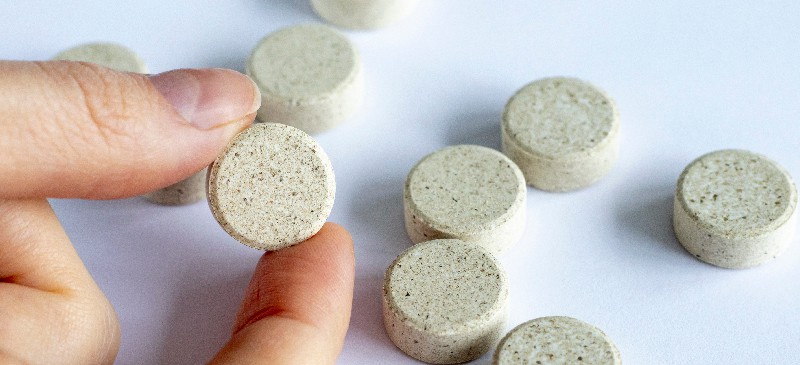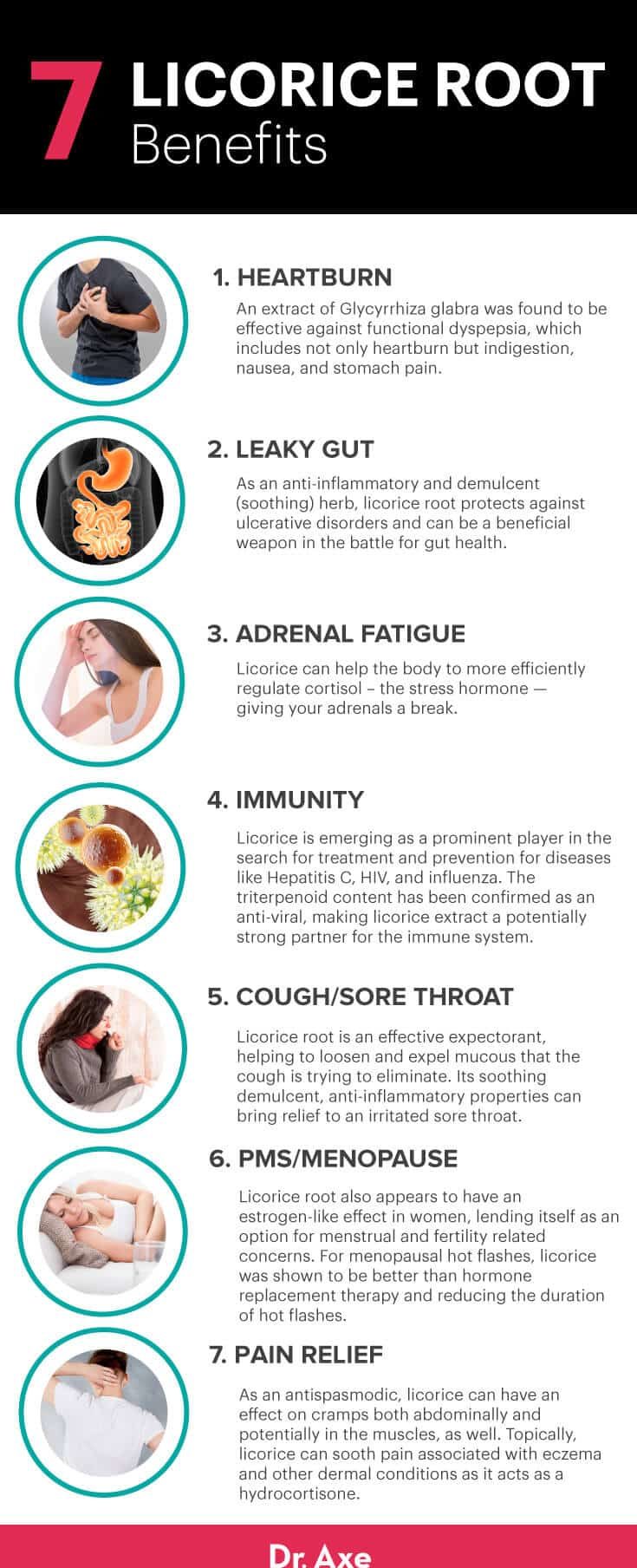Licorice Root for Adrenal Fatigue and Leaky Gut (original) (raw)
Evidence Based
This Dr. Axe content is medically reviewed or fact checked to ensure factually accurate information.
With strict editorial sourcing guidelines, we only link to academic research institutions, reputable media sites and, when research is available, medically peer-reviewed studies. Note that the numbers in parentheses (1, 2, etc.) are clickable links to these studies.
The information in our articles is NOT intended to replace a one-on-one relationship with a qualified health care professional and is not intended as medical advice.
This article is based on scientific evidence, written by experts and fact checked by our trained editorial staff. Note that the numbers in parentheses (1, 2, etc.) are clickable links to medically peer-reviewed studies.
Our team includes licensed nutritionists and dietitians, certified health education specialists, as well as certified strength and conditioning specialists, personal trainers and corrective exercise specialists. Our team aims to be not only thorough with its research, but also objective and unbiased.
The information in our articles is NOT intended to replace a one-on-one relationship with a qualified health care professional and is not intended as medical advice.
May 15, 2023

Licorice has become synonymous with a strong candy flavor, but the herb itself — Glycyrrhiza glabra — has very different strengths. An adaptogenic herb, licorice root can be found growing in Europe, the Mediterranean and Asia, and it’s been used for thousands of years and dozens of purposes, including as a leaky gut supplement.
If licorice root benefits so many conditions, though, why do we only think of it as a candy flavoring? What is DGL licorice root, and is it necessary to buy special licorice root supplements?
Let’s walk through the history, uses and questions surrounding licorice root. This ancient herb has much to offer.
What Is Licorice Root?
Licorice is a member of the legume family, and while there are species that grow in the U.S., Glycyrrhiza glabra is primarily native to Europe and Asia. Also, you might see “Chinese licorice” listed on products. In that case, it’s likely Glycyrrhiza uralensis, the second variety.
Licorice root benefits are primarily the same between the two varieties, according to the Journal of Advanced Research. However, it’s worth noting that glabra is typically the variety referred to when discussing licorice root.
Glycyrrhiza’s name reflects its most popularly known claim to fame: “sweet root.” With an extract that can be 30 to 50 times sweeter than sugar, we can see why our ancestors were inspired to turn it into candy. In Traditional Chinese Medicine, anti-inflammatory licorice root has been used for centuries for many of the same uses that science has confirmed now — coughs and colds, gastrointestional issues, and female reproductive issues.
One interesting note about the way licorice has been used in Chinese medicine is that it was used as a “guide drug.” Licorice root was used in tandem with other herbs and remedies to enhance their effects and essentially guide the other herbs to where they would be most beneficial. In 2013, this use was observed and reviewed by the Tianjin University of Traditional Chinese Medicine. This ancient purpose, along with other licorice root benefits, no doubt contributed to licorice root being the most used herb in Chinese medicine!
Europeans didn’t ignore the benefits of licorice as supplement, either. Licorice root has documented uses from antiquity, from ancient Greece and Rome to the Middle Ages and beyond.
Now, that familiarly strong licorice flavor is usually replicated by the similarly flavored anise seed (a common biblical herb), but you can still get genuine licorice candy — usually “black licorice” to distinguish it from the red imitation candy.
Even when the root extract is used just to sweeten, it can’t be ignored as a potent compound. And while the root is the primary portion used for supplements and remedies, the leaves have been evaluated for their antimicrobial benefits, as well. In an Iranian Journal of Pharmaceutical Research study, the leaves tested well against bacteria and thus may work as a staph and candida remedy.
DGL Licorice vs. Licorice Extract
Thanks to its odd name, licorice supplement labels can be a bit daunting to process. In order to understand deglycyrrhized (DGL) licorice, we first need to break down some of the main compounds in licorice root extracts.
Licorice root is so complex that researchers have isolated 134 different compounds in the glabra variety and 170 in Chinese licorice. Obviously, we don’t have time to discuss them all and researchers learn more about compounds in herbs every day. But there are at least four main types of compounds found in licorice root: flavonoids, coumarins, triterpenoids and stilbenoids.
There are countless compounds and variations within each categorization, but we can generally understand a compound by its type:
- Flavonoids: Flavonoids, for example, are responsible for a plant’s deep pigment (like the blue in blueberries or the black in black licorice) and are usually rich in antioxidants and anti-inflammatory, among other benefits.
- Coumarins & Stilbenoids: Coumarins and stilbenoids are polyphenols that are often anti-inflammatory and antibiotic.
- Triterpenoids: Triterpenoids are typically stronger in nature and sometimes include steroidal substances.
A prominent example of the benefits found in these compounds is the flavonoid glabradin, which contributes to numerous licorice root benefits. First described in the 1970s, researchers have since discovered many of its effects. It’s observed to be anti-inflammatory, have an effect on metabolism and function as a phytoestrogen — which can sometimes benefit women’s health in many ways.
The licorice plant’s namesake and cause of the sweet flavor in the root is the triterpenoid glycyrrhizin. It’s a potent anti-inflammatory, mild natural laxative and expectorant, among other benefits..
Glycyrrhizin has been noted to create side effects when overused, such as increased blood pressure, reduced potassium levels, edema (swelling) and other issues. Because this would exclude people with blood pressure, liver and kidney issues, as well as pregnant women, licorice supplements can be standardized to remove this compound — known as deglycyrrhized licorice.
For otherwise healthy adults without a contraindication, however, glycyrrhizin can absolutely be beneficial, as noted above. In order to minimize the risk of complications, licorice root extract shouldn’t be overused, and it shouldn’t be taken in large doses long term without giving the body a break periodically. Stick to 6–18 grams per day at the maximum if you’re taking licorice every day — for comparison, most supplements containing licorice root have less than one gram per serving.
Limitations aren’t the same as contraindication. Licorice root benefits a number of conditions and is an excellent addition to any herbal supplement toolbox.
Benefits
1. Heartburn and acid reflux
Published in the journal Evidence-based Complementary and Alternative Medicine, an extract of Glycyrrhiza glabra was found to be effective against functional dyspepsia, which includes not only heartburn but also a natural remedy for nausea, indigestion and stomach pain.
The type used for the study was DGL licorice, which left participants without any negative side effects associated with glycyrrhizin. DGL can be purchased as chewable tablets that can be taken before meals.
2. Leaky Gut
Tied to systemic health issues, leaky gut syndrome can be difficult to tackle. As an anti-inflammatory and demulcent (soothing) herb, licorice root works as a natural remedy for ulcers and can be a beneficial leaky gut supplement and gut health supplement.
3. Adrenal fatigue
In spite of living in a relatively simple time in history, our society is plagued by environmental, physical and mental stress disorders. So many of us have sent our adrenal glands in overdrive, like we’re running from wooly mammoths when we’re really just dealing with a budget issue or a decision at work — resulting in adrenal fatigue.
In the medical journal Molecular and Cellular Endocrinology, licorice was found to help the body more efficiently regulate cortisol — the stress hormone — thus giving your adrenals a break. It turns out it’s one of the main adaptogen herbs to help improve stress response.
4. Immunity
Licorice is emerging as a prominent player in the search for treatment and prevention for diseases like hepatitis C, HIV and influenza. The triterpenoid content has been confirmed as an antiviral herb, making licorice extract a potentially strong partner for the immune system.
One study published in Food Chemistry described licorice as having “antioxidant, free-radical scavenging, immunostimulating” properties.
5. Cough/sore throat
Licorice root benefits a sore throat or cough immensely as an effective expectorant, helping to loosen and expel mucus that the cough is trying to eliminate. Its soothing demulcent, anti-inflammatory properties can bring fast relief for sore throat.
Demulcents need to make contact with the part of the body that needs to be soothed, so extracts in cough drops and syrups, as well as tea, are most effective.
6. PMS/Menopause
Licorice root also appears to have an estrogen-like effect in women, lending itself as an option for menstrual- and fertility-related concerns, including as a natural remedy for PMS. (21)
For treatment of menopause, licorice was shown in a Health Care for Women International study to be better than hormone replacement therapy at reducing the duration of hot flashes. It’s also one of the most recommended menopause supplements.
7. Pain relief
As an antispasmodic, licorice can have an effect on muscle cramps both abdominally and potentially in the muscles, as well. Topically, licorice can alleviate eczema discomfort and other dermal conditions as it acts as a hydrocortisone.
Anti-inflammatory benefits may also help relieve pain, including acting as a natural remedy for joint pain.
Side Effects
The side effects of licorice root are primarily connected to glycyrrhizin, so if any of them concern you, DGL licorice is probably the best option. Never consume licorice root extract if you’re pregnant, as it may increase risk of early deliver or miscarriage, or if you have heart, liver or kidney issues.
Some evidence suggests taking licorice in supplement form may have estrogen-like effects on female hormone sensitive conditions (breast cancer, uterine cancer, ovarian cancer, endometriosis, uterine fibroids) and should not be taken by people with such diseases. It may also worsen hypertonia (a muscle condition caused by nerve disease), potassium deficiency (hypokalemia) or erectile dysfunction.
If you do consume licorice root extract, the maximum recommended dosage is a maximum of six to 18 grams a day in order to limit the amount of glycyrrhizin.
Side effects to watch for include edema, high blood pressure, low potassium levels and chronic fatigue. Also, stop taking licorice root two weeks before surgery, as it may interfere with blood pressure control during surgical procedures.
